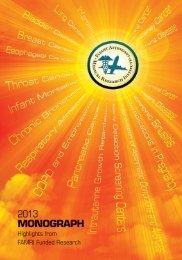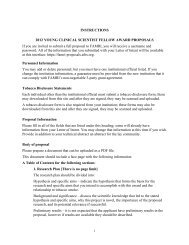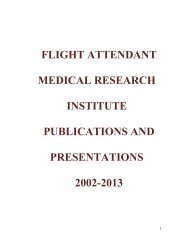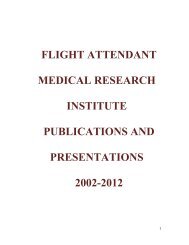- Page 3 and 4:
MISSION FAMRI is an Independent Not
- Page 5 and 6:
FOREWORD David Sidransky, MD, Vice-
- Page 7 and 8:
FAMRI CENTERS OF EXCELLENCE........
- Page 9 and 10:
PAI-1 And Airway Remodeling In Seco
- Page 11 and 12:
Promoter Hypermethylation As A Mole
- Page 13 and 14:
Expression Profiling Of Blood In Lu
- Page 15 and 16:
Inhibition Of Hedgehog Signaling By
- Page 17 and 18:
Genetic Epidemiology Of Pulmonary F
- Page 19 and 20:
Reducing Second Hand Tobacco Smoke
- Page 21 and 22:
SINUSITIS .........................
- Page 24 and 25:
INTRODUCTION David M. Burns, MD, Pr
- Page 26 and 27:
FAMRI AWARD CATEGORIES The Board of
- Page 28 and 29:
HIGHLIGHTED FAMRI FUNDED RESEARCH C
- Page 30 and 31:
Xia L, Crane-Godreau M, Deng B, Lei
- Page 32 and 33:
Farassati F, Yang A-D, Lee P WK. On
- Page 34 and 35:
Nicotine & Tobacco Research 2007;9:
- Page 36 and 37:
homes where smoking is banned are m
- Page 38 and 39:
a survey-based COPD severity score.
- Page 40 and 41:
allergic rhinitis have increased re
- Page 42 and 43:
However, while the economic costs a
- Page 44 and 45:
mitochondrial adenosine diphosphate
- Page 46 and 47:
CHR, and CDE. The promoter architec
- Page 48 and 49:
Trends Mol Medicine 2007;13:150-157
- Page 50 and 51:
was also demonstrated to be effecti
- Page 52 and 53:
and are currently in clinical testi
- Page 54 and 55:
Academic Societies’ Meeting. Hono
- Page 56 and 57:
acceptability, and usefulness of us
- Page 58 and 59:
utilize telephone conference call f
- Page 60 and 61:
FAMRI-FUNDED RESEARCH COMBATING EFF
- Page 62 and 63:
act via limited proteolysis of subs
- Page 64 and 65:
was significantly higher in Nic:RSV
- Page 66 and 67:
presenting cells (APC) in vitro; an
- Page 68 and 69:
FAMRI Supported Publications Collac
- Page 70 and 71:
nisms of combostatin and its parent
- Page 72 and 73:
Bladder cancer progression involves
- Page 74 and 75:
45, NPV = 8%), 3 months (n = 42, NP
- Page 76 and 77:
THE EFFECT OF ADENYLATE KINASE 3 ON
- Page 78 and 79:
Agency report in 2006 (ftp://ftp.ar
- Page 80 and 81:
Narayan S, Jaiswal AS. Structure-ba
- Page 82 and 83:
in the duration of the cigarette sm
- Page 84 and 85:
ENVIRONMENTAL AND GENETIC RISK FACT
- Page 86 and 87:
Estrogen activates the cell cycle b
- Page 88 and 89:
Schaeffer MW, Sinha Roy S, Mukherje
- Page 90 and 91:
east tumors. When breast cancer cel
- Page 92 and 93:
is to identify and characterize key
- Page 94 and 95:
of these target genes are regulated
- Page 96 and 97:
CANCER, GASTRIC CURRENT RESEARCH GA
- Page 98 and 99:
CANCER, HEAD AND NECK CURRENT RESEA
- Page 100 and 101:
Tran HM, Shi G, Li G, Carney JP, O
- Page 102 and 103:
ANALYSIS OF SERUM PEPTIDES ASSOCIAT
- Page 104 and 105:
(BE), gastroesophageal reflux disea
- Page 106 and 107:
CANCER, HEAD AND NECK COMPLETED RES
- Page 108 and 109:
in normal epithelia, was shown to b
- Page 110 and 111:
Commentary: Bonn, D. Urine test for
- Page 112 and 113:
disease (COPD), innate immune dysfu
- Page 114 and 115:
SCLC. The foundation for this appro
- Page 116 and 117:
Witta SE, Gemmill RM, Hirsch FR, Co
- Page 118 and 119: MYC-induced lymphomagenesis. It wil
- Page 120 and 121: PUMA Mediates Intestinal Apoptosis
- Page 122 and 123: leomycin-induced pulmonary fibrosis
- Page 124 and 125: dimensional magnetic resonance micr
- Page 126 and 127: vaccine, Ad.p53-DC, was well tolera
- Page 128 and 129: esults of these studies should also
- Page 130 and 131: prostaglandin E2 in non-small-cell
- Page 132 and 133: were sequenced from NSCLC tissue an
- Page 134 and 135: expression has a protective effect
- Page 136 and 137: evaluate the expression level of Id
- Page 138 and 139: as a target for the sensitization o
- Page 140 and 141: Cancer Biol Ther 2006;5(1):48-53. A
- Page 142 and 143: REGULATION OF TGF BETA SIGNALING IN
- Page 144 and 145: among men exposed to cigarette smok
- Page 146 and 147: FAMRI Supported Publications Gibbs
- Page 148 and 149: or 500 ppm CO for 30 days. Blood pr
- Page 150 and 151: adiponectin signals through activat
- Page 152 and 153: CARDIOVASCULAR COMPLETED RESEARCH S
- Page 154 and 155: EFFECTS OF SECOND HAND TOBACCO SMOK
- Page 156 and 157: nicotine administration in vivo on
- Page 158 and 159: degradation of type III collagen in
- Page 160 and 161: wild-type (WT) mice and mice geneti
- Page 162 and 163: REDUCED NEUTROPHIL DEATH IN TOBACCO
- Page 164 and 165: H 2 O 2 -induced nuclear fragmentat
- Page 166 and 167: The aims of this study are: 1) to d
- Page 170 and 171: propagation of emphysema by alveola
- Page 172 and 173: duced mainly by alveolar type-II ep
- Page 174 and 175: concentrations of inflammatory indi
- Page 176 and 177: subglottis. Arch Otolaryngol Head N
- Page 178 and 179: detector row CT (MDCT), 2005. Prese
- Page 180 and 181: of smoke-free homes: findings from
- Page 182 and 183: Travers MJ, Hyland A. Wisconsin Air
- Page 184 and 185: understood there would be several v
- Page 186 and 187: Travers MJ, Cummings KM, Repace JL,
- Page 188 and 189: REDUCING SHS: CARDIAC AND ASTHMA OU
- Page 190 and 191: tobacco companies fought tobacco co
- Page 192 and 193: consumer acceptance through Web-bas
- Page 194 and 195: housing, there is a need for scient
- Page 196 and 197: youth to magazine tobacco advertisi
- Page 198 and 199: Stukel JM, Heys JJ, Caplan MR. Opti
- Page 200 and 201: EXPOSURE TO SECOND HAND TOBACCO SMO
- Page 202 and 203: aldosterone, cortisol, corticostero
- Page 204 and 205: the expression of numerous genes th
- Page 206 and 207: and signaling functions), is suppre
- Page 208 and 209: development and behavior, from the
- Page 210 and 211: dams exposed to 75 ppm (1 pack/day)
- Page 212 and 213: Poster Presentation at the 11th Int
- Page 214 and 215: inhibition among Blacks and Whites.
- Page 216 and 217: tobacco exposure (biologic measures
- Page 218 and 219:
ularly true for the chemokine GRO-a
- Page 220 and 221:
EPITHELIUM AND IMMUNOMODULATION IN
- Page 222 and 223:
patency was best assessed using hig
- Page 224 and 225:
significant increases in sinusitis
- Page 226 and 227:
VISION ONGOING RESEARCH GENE PROFIL
- Page 228 and 229:
FAMRI DISTINGUISHED PROFESSORS FAMR
- Page 230 and 231:
is a strong motivator for smoking c
- Page 232 and 233:
egulations and attitudes towards th
- Page 234 and 235:
y the tobacco industry of the harmf
- Page 236 and 237:
epair capacity assays. Her collabor
- Page 238 and 239:
Society for Research on Nicotine an
- Page 240 and 241:
PERSONAL THOUGHTS FROM THE FLIGHT A
- Page 242 and 243:
APPENDICES: LIST OF FAMRI GRANTEES
- Page 244 and 245:
BDA Butter, Karen A., MLS Universit
- Page 246 and 247:
AWARD INVESTIGATOR INSTITUTION TITL
- Page 248 and 249:
AWARD INVESTIGATOR INSTITUTION TITL
- Page 250 and 251:
AWARD INVESTIGATOR INSTITUTION TITL
- Page 252 and 253:
AWARD INVESTIGATOR INSTITUTION TITL
- Page 254 and 255:
APPENDICES: ACRONYMS The following
- Page 256 and 257:
apoptosis. COPD. c2008;5:153-162. A
- Page 258 and 259:
KW, Lengauer C. Identification of c
- Page 260 and 261:
Brait M, Begum S, Carvalho AL, Dasg
- Page 262 and 263:
Measuring disease-specific quality
- Page 264 and 265:
Mukherjee M, Schuldenfrei A, Kowals
- Page 266 and 267:
sion attenuates cigarette smoke- or
- Page 268 and 269:
Kuck J, Bauer JA. Racial difference
- Page 270 and 271:
2008;26:856-862. Helfrich BA, Raben
- Page 272 and 273:
acute nephritis. Am J Nephrol 2008
- Page 274 and 275:
O’Malley BW. Double DNA repair hi
- Page 276 and 277:
of base excision repair pathways. C
- Page 278 and 279:
virotherapy of anaplastic thyroid c
- Page 280 and 281:
Marsit CJ, Posner MR, McClean MD, K
- Page 282 and 283:
2008. Mukhopadhyay S, Mukherjee S,
- Page 284 and 285:
Pache JC, Burton DW, Deftos LJ, Has
- Page 286 and 287:
2004;114:1248-1259. Rangasamy T, Gu
- Page 288 and 289:
Childhood pregnancy (10-14 years ol
- Page 290 and 291:
J Public Health 2004;94:1959-1964.
- Page 292 and 293:
2007;67(11):5337-5344. Sullivan AK,
- Page 294 and 295:
2005;90:5265-5269. Vassallo R, Kroe
- Page 296 and 297:
Fong Y. Effective treatment of head
- Page 298 and 299:
apoptosis control. Biochem Biophys
- Page 300 and 301:
APPENDICES: INDEX BY AUTHOR Abdulla
- Page 302 and 303:
Palmer, James N 235 Pan, Quintin 23
- Page 304 and 305:
NOTES: 2 9 2 P A G E
- Page 306:
ATTRIBUTION FLIGHT ATTENDANT MEDICA







